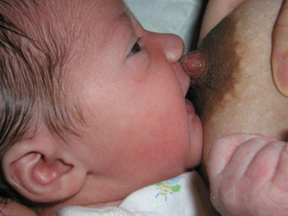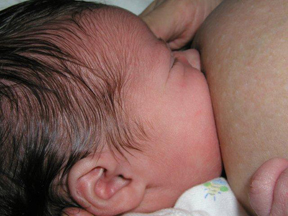Normal Newborn Sleep and Breastfeeding Patterns:

First 2-hours after birth
Quiet-alert
The perfect opportunity to establish breastfeeding. Evidence shows that babies “imprint” on their first oral experience, and will remember this later. Breastfeeding at this point can also help stop postpartum bleeding. Consider the first feedings as “practice” for both mom and baby. Even if baby only licks or nuzzles, it is helping to orient baby toward the breast and stimulates milk-producing hormones in the mother.
Next 12 hours
Deep sleep
This is the time for both mother and baby to rest and recover from the birth. The breast should be offered every 2-3 hours during the day and every 4-5 hours a night, altering with waking techniques, such as unbundling and bringing baby into an upright position (doll-eyes effect). Most babies do fine with very little to eat during this period. (Protocol: Blood sugar with no feeding for 5-6 hours.)
Next 12-36 hours
Hungry!
Baby may seem insatiable with frequent feeding cues, i.e. licking lips, hand to mouth motion, rooting, and crying. This is a normal stage and is meant to stimulate the mother’s milk supply. It does not indicate that the mother does not have enough milk. The colostrum is there! It has been there since the middle of the pregnancy. Colostrum is like concentrated milk. It is high in fat and protein with special immunities to protect the baby after the birth. It also has a laxative effect to clear the meconium after the birth, which helps prevent jaundice. A few teaspoons of colostrum, are equal to an ounce of formula. If baby will not latch, a few drops of colostrum hand expressed into baby’s’ mouth is often enough to maintain blood sugar.
Input-Output
We know how much a breastfeeding baby is getting by output. The guideline is one wet diaper for each day of life the first week: 1 wet on day one, 2 wet on day two, etc. We expect 2-3 stools a day, with the stool transitioning from black meconium to green, and finally yellow by Day 4.
Technique
No matter which position is used, Off-Center Latch is the Key to a Deep Latch. Recent studies show that it is the lower jaw and tongue that milk the breast and draw it deep. The closer the lower lip lands to the tip of the nipple, the more shallow the latch will be. The goal is to have the lower lip land as far away as possible from the tip of the nipple.



Nose-to-nipple positioning.
Football hold
Cross-Cradle hold
Side-lying position
Laid-back breastfeeding position
Cradle hold (least favorable for a newborn)
Baby should be nose-up, chin-up, never pushing on the back of the baby’s head.
Order of feeding reflexes:
- rooting side-to-side
- wide-open mouth
- suck-suck-suck
Tapping or tickling the upper lip with the nipple elicits the rooting reflex. Once you see a side-to-side motion this is your cue, you are about to get the wide-open mouth. Bring the baby to the breast “quickly” before baby begins sucking. Baby should never be allowed to suck the nipple in. This will result in a shallow latch.
“If it Hurts, it’s Wrong”
Breastfeeding should never hurt.
Pain is a red flag that the something is not right with the latch, which could result in insufficient milk transfer.
Screen for a short/tight lingual frenulum i.e. tongue-tie.
How many minutes?
Rule of thumb: Baby should be allowed to feed from the first breast for as long as possible. Once baby ends the feeding, attempt to burp, and offer the second side. Baby may or may not take the second side. This is normal. Ten minutes of active suckling constitutes a feeding. “Ten minutes on each side” may not be realistic in the beginning.